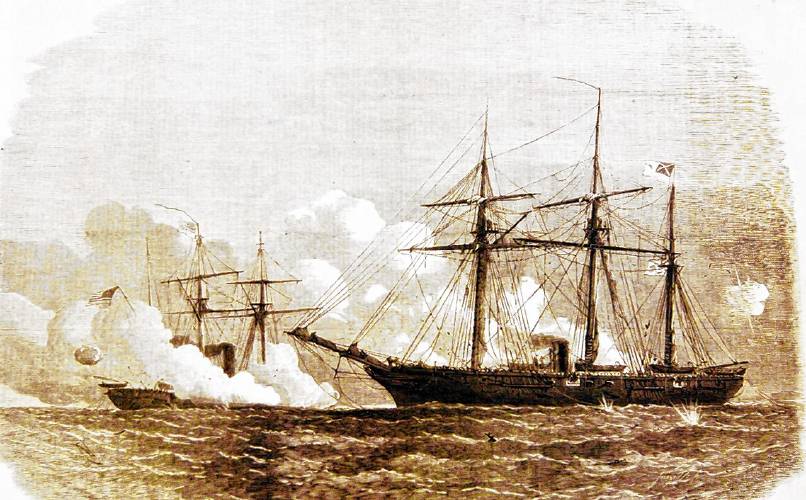From the archives: The legacy of the USS Kearsarge

The Kearsarge and Alabama in battle. Courtesy
| Published: 02-04-2024 8:00 AM |
Ashley Miller shares this month’s story with ConcordTV. Watch the episode on YouTube.
One of the most famed naval battles of the Civil War involved a ship created in, and named for, the Granite State.
The USS Kearsarge was built in the Portsmouth Naval Shipyard. The oldest continuously operable naval shipyard in the country, it was established on June 12, 1800. This region has a long tradition of shipbuilding. Since the colonies were first settled, New Hampshire lumber has been used to construct wooden vessels. The HMS Falkland, considered to be one of the first British warships, was created in New Castle, New Hampshire, in 1696. During the American Revolution, the Raleigh was created directly across the harbor on Badger’s Island in Kittery, Maine, and appears on the New Hampshire state seal.
Between February 5, 1862, when the ship first set for seas, and June 1864, the Kearsarge visited numerous foreign ports in European waters seeking Confederate privateers.
On June 13, 1864, Captain John Winslow received word that the CSS Alabama was ported at Cherbourg, France. The Kearsarge arrived on the 14th, forced to wait for Alabama to leave port due to French neutrality laws. On June 19, Alabama left port, giving Captain Winslow the perfect opportunity to act.
The engagement lasted roughly an hour. Hundreds of excited onlookers gathered on the cliffs overlooking the harbor to watch the battle unfold.
The ships circled each other seven times, vying for a tactical advantage. Rapid, wild fire was streaming in from the Alabama, but the Kearsarge offered a much more deliberate approach, with “instructions given to point the heavy guns below rather than above the waterline, and clear the deck with the lighter ones.” The Alabama surrendered, with the remaining crew and Captain Raphael Semmes escaping to a British vessel. Captain Winslow spared them, and within twenty minutes of their surrender, the Alabama had sunk into the British Channel.
Within days, artists began to depict the battle in paintings, prints, poems, lithographs, and musical pieces.
Article continues after...
Yesterday's Most Read Articles
 New Hampshire targets sexual exploitation and human trafficking inside massage parlors
New Hampshire targets sexual exploitation and human trafficking inside massage parlors
 New Hampshire legalizes public alcohol consumption in designated ‘social districts’
New Hampshire legalizes public alcohol consumption in designated ‘social districts’
 State rules Epsom must pay open-enrollment tuition to other school districts, despite its refraining from the program
State rules Epsom must pay open-enrollment tuition to other school districts, despite its refraining from the program
 ‘A little piece of everything I like’: New Pittsfield barbershop brings more than a haircut to downtown
‘A little piece of everything I like’: New Pittsfield barbershop brings more than a haircut to downtown
 Remembered: Friends recall stories about the lives of those who died without housing
Remembered: Friends recall stories about the lives of those who died without housing
 Town turmoil: Chichester town administrator resigns again
Town turmoil: Chichester town administrator resigns again
In the thirty years following its triumphant victory, the USS Kearsarge was commissioned and decommissioned several times. In the latter half of 1889, the Kearsarge brought Frederick Douglass to Haiti, where he served as the newly appointed ambassador.
On a fateful voyage to Nicaragua, the Kearsarge struck a reef off of Roncador Cay on February 2, 1894. The crew made it safely to shore. Congress appropriated $45,000 to salvage the vessel and return it to the United States, but the effort was unsuccessful as the wreck was deemed beyond repair. A number of artifacts were removed from the ship, including a sternpost with an unexploded Confederate shell embedded in it, the ship’s bell, deadlight, and the storm ensign flag.
The legacy of this famed ship endures, however, with four subsequent ships named in its honor, carrying the weight of naval history.
From the Archives is a monthly column highlighting the history and collection of the New Hampshire State Archives, written by Ashley Miller, New Hampshire State Archivist. Miller studied history as an undergraduate at Penn State University and has a master’s degree in history and a master’s degree in archival management from Simmons College.







 Lavender haze: Purple fields bloom at Warner farm
Lavender haze: Purple fields bloom at Warner farm Arts in the Park returns for July
Arts in the Park returns for July Hopkinton art gallery showcases “Creativity Beyond Convention”
Hopkinton art gallery showcases “Creativity Beyond Convention” AROUND CONCORD: Your guide to free summer music
AROUND CONCORD: Your guide to free summer music
